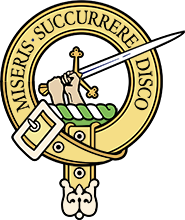Baker / Baxter / M'Baxter (Mac-bacsdair)

Above, the Cowal Peninsula, a Baxter homeland as seen across Loch Fyne from Knapdale, another Clan MacMillan homeland.
"There was another of the Family of Knap, called Archibald Baan M'Millan, who having killed a certain Man of Repute, was so closely pursued upon committing the Slaughter, that coming by the Earl of Argyle's Residence, he was forced in to the Earl's Kitchen for Refuge, where the Cook, being at the same Time baking, hastily caused Macmillan to exchange Cloaths with him, and fall to bake, which prevented his being apprehended, or discovered by the Pursuers; after which this Macmillan, and his Progeny, assumed the Surname of M'Bhaxters, yet retained by them. Those of this Name reside mostly in Cowal in Argyleshire; the principal Man of them being Nivein M'Bhaxter in Glendarowal. They term themselves in English, Baxters" (William Buchanan of Auchmar, An Account of the MacMillans, 1723).
Though the Reverend Somerled MacMillan asserted that Archibald "am bacasdair" was brother to Alexander MacMillan of the Cross - who lived in the 1470s - it is not apparent upon what, if any, evidence his claim was based; and the fact that a Patriciu Baxster who appears on the record in 1377 is to be found then in the company of Thomam McMolyn suggests that the sept may have been much older in origin than the late clan bard thought.
Thome Baxster appears in 1481 as a tenant of lands in Cessintully - at one time part of the Leny estates in Menteith - along with Donald MacCane (see sept of MacCan/Cannan). In 1493 Donald McBaxter witnesses a sasine in Craignish, an estate to the north of Knapdale whose lairds were probably descendants of Dougall mac Malcolm mhic Mhaolain, and on whose lands resided the Barons McIlveil (i.e. MacGhillemhaoil) of Barrichbean - the ancestors of the sept of McGill. Other early recorded MacBaxters in Argyll - and therefore by geographical location most likely to have been MacMillan Baxters - are: Joh. M'Baxter, tenant in Ardinsleat of Strathauchy (probably Glen Orchy) in 1564; Donald and John MacBaxter, retainers of the Prior of Ardchattan in 1585; Gilcrist McBaxter who's listed in the "Kintyre Papers" as one of the bowmen raised by Colonel Alexander MacNaughten for service in France in 1627; Archibald McBaxter who was charged by the Synod of Kintyre with fornication and cohabitation in 1650; Gilbert Baxter in Kildalven who was fined for "killing kipper fish" in 1672 (Argyll Justiciary Records); and John MacVaxter who held a "kerrowran" - a measure of land - in Islay in 1685.
Since the trade of baker was common in pre-20th century Scotland only those bearing the name (Mac)Baxter in areas of the country associated with the MacMillans are likely to have belonged to the sept; but the John son of Donald MacBaxter who's recorded in Roseneath parish in 1620 could have been a MacMillan in origin since this part of Dunbartonshire is just accross the water from the Cowal peninsula - which is where William Buchanan of Auchmar locates the "principal man" of the sept in the early 18th century. Glendaruel of Cowal was not only linked with Knapdale in the earliest known charter connecting the MacMillan kindred with their ancestral seat (dated 1318), but it was also home to another branch of the MacCanes - who are usually recorded in this area as MacChannanichs - and to the sept of MacGibbon. The Nivein M'Bhaxter who's identified by Auchmar as the sept's chieftain in 1723 is probably the same man who appears in the Argyll Justiciary Records in 1711 as Niven Baxter, tenant of Colin Campbell younger of Glendaroull, in connection with the theft of a cow from his lands. Contemporary with him were John and William Baxter, merchants in Glasgow (Argyll Sasines 1701 and 1721) - the latter presumably the same man as the William Baxter Merchant-Burgess of Glasgow who was admitted to be a Burgess of Inverary in 1707.
Prominent Baxters in modern times.
Probably the most distinguished Scottish Baxters in modern times have been the Baxters of Kincaldrum and their cousins the Baxters of Balgavies, who were both branches of the family of Baxter Brothers and Co., cloth-makers from Dundee who supplied the sails for the whole of Nelson's fleet at Trafalgar. Members of the same family were later prominent in British politics, and their present representative is Normile Baxter of the House of Aquahorthies by Inverurie in Aberdeenshire.
Though this family's roots can be traced back to the mid-17th century in Angus, they believe themselves to be MacMillan Baxters, as is evident from the Kincaldrum coat of arms - shown above - which is based on that of the Galloway and Ulster MacMillans. The Balgavies family apparently had arms based on those of the Knapdale MacMillans (i.e. Argent, a lion rampant, sable; on a chief per fesse azure and gules, three mullets, of the first). See the Heraldry page for the relevant MacMillan coats.
There are many descendants of this family in North America, who in recent years have commissioned a distinctive Baxter tartan which is on display at the Clan MacMillan International Centre.
Other prominent bearers of this sept-name today include Colin Baxter the photographer and Graeme William Baxter the painter; but perhaps the most well known are the Baxters of Speyside, makers of soups, jams and other Scottish foodstuffs. This family firm was founded by George Baxter, a gardener at Gordon Castle who borrowed £100 from an uncle to set up the business in the mid-19th century; and it's now headed by his grandson Gordon, his wife Ena, and their children Audrey, Andrew and Michael.
Though not all Baxters in Scotland and around the world can claim to be of MacMillan descent, all are made welcome in Clan MacMillan branches and societies.
